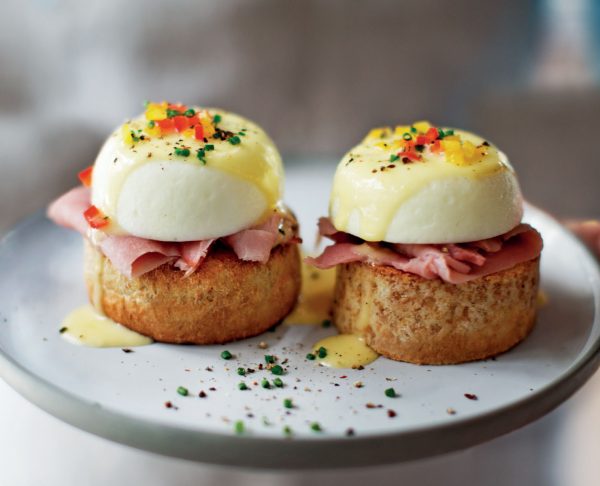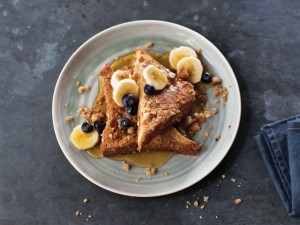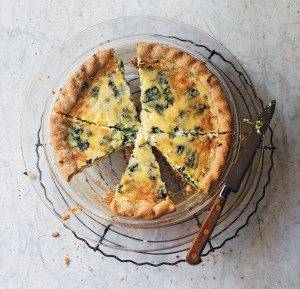Holiday Entertaining: Brunch Recipes
December 2, 2015
With the holiday season in full swing, it’s time to start thinking about what you’ll serve your guests at your Christmas, Hanukkah, and New Year’s Eve gatherings. Enjoy the recipes below or click on the News tab for recipes and tips for your entire holiday meal.
Classic Eggs Benedict
Makes 6 servings
Poached Eggs:
To poach eggs in an egg poacher, simply bring 1 1/2 inches of water to a full boil in a deep skillet over high heat, then reduce the heat to low to keep the water at a simmer. Brush the insides of the poaching cups with Clarified Butter and immediately crack an egg into each. Poach according to the manufacturer’s directions until the whites are set, about 3 minutes. Remove the eggs and let drain on paper towels, if needed. Serve hot.
If you don’t want to use a poacher, bring 1 1/2 inches of water to a full boil in a deep skillet over high heat, then reduce the heat to low to keep the water at a simmer. Crack each egg into a ramekin. Gently slide the eggs, one at a time, into the simmering water. Simmer, spooning the white of each egg back over on itself to help the egg keep an oval shape, until the whites are set, about 3 minutes. Using a slotted spoon, lift out each egg and drain on paper towels.
Hollandaise:
3 large egg yolks, at room temperature
1 tablespoon water
8 ounces (227 grams) unsalted butter, softened
1 tablespoon plus 1 teaspoon fresh lemon juice
Fine sea salt
12 thin slices best-quality ham, warmed
12 Poached Eggs, hot
6 Whole Wheat English Muffins (page 147), tops trimmed flat, split into halves, and toasted
Finely diced red and yellow bell peppers, for garnish
Snipped fresh chives, for garnish
Freshly ground black pepper, for garnish
To prepare the hollandaise: Fill the bottom of a double boiler or a large saucepan halfway with water and bring to a simmer. In the top of the double boiler or a nonreactive metal bowl that fits snugly over the saucepan, whisk the egg yolks and water.
Set the top of the double boiler or bowl over the simmering water and whisk until the yolks are very pale and thick, about 3 minutes. If the mixture begins to heat too quickly and threatens to curdle and get lumpy, remove the top pan or bowl from the saucepan and whisk for a while before setting it over the simmering water again. When the yolks are ready, you should be able to see the bottom of the bowl with each stroke.
Continue to whisk while adding the butter a little at a time. When all of the butter has been incorporated and the mixture is silky smooth, whisk in the lemon juice and season to taste with salt.
Place 1 warm ham slice and then 1 hot poached egg, yolk side down, on top of each freshly toasted English muffin half. Spoon the hollandaise sauce on top, letting it run down the sides of the eggs and muffins. Garnish with the bell peppers, chives, and black pepper. Serve immediately.
Clarified Butter
Clarified butter is butter with the milk solids removed. The process is very easy: Boil the butter to evaporate some of the water and separate the milk solids from the fat. The resulting clarified butter can then be chilled until firm. Clarified butter is a must for greasing a griddle or waffle iron and it can be used like any cooking fat for sautéing or panfrying.
1 pound (454 grams) unsalted butter, cut into 1/4-inch cubes
Put the butter in the top of a double boiler. Place over simmering water in the bottom of the double boiler and melt the butter, stirring occasionally and skimming off any foam from the surface. This could take about 20 minutes.
Pour all of the melted butter into a pint container and cool, uncovered, to room temperature. Then cover tightly and chill until the butter is firm, at least 2 hours, or up to overnight.
Using the handle of a wooden spoon, poke a hole through the firm butter, reaching down to the bottom of the container. Pour off the milky liquid, leaving the yellow clarified butter in the container. The clarified butter can be refrigerated in the same airtight container, covered, for up to 3 weeks.
Quick Clarified Butter:
In a medium saucepan, bring the butter to a full boil over medium heat and cook for 30 seconds. Remove from the heat and let stand for 5 minutes. Skim the foam off the top of the butter and discard. Then pour the clarified butter into a small bowl, leaving the solids behind in the pan. Use immediately, or let cool for 20 minutes, then cover and refrigerate for up to 3 weeks.

Apple Cider French Toast with Streusel
Makes 8 servings
Streusel:
1 cup (142 grams) unbleached all-purpose flour
2 tablespoons packed light brown sugar
2 tablespoons superfine sugar
3/4 teaspoon ground cinnamon
1/8 teaspoon freshly grated nutmeg
4 tablespoons (57 grams) unsalted butter, melted and cooled
1/2 teaspoon pure vanilla extract
12 large eggs
1 1/2 cups (336 grams) fresh apple cider
1 teaspoon pure vanilla extract
1/8 teaspoon freshly grated nutmeg
1 large loaf (18 ounces; 510 grams) tender white bread, cut into eight 1-inch-thick slices, then cut diagonally in half
Clarified Butter, as needed
Softened unsalted butter, for serving
Warm pure maple syrup, for serving
Sliced bananas, for serving
Blueberries, for serving
Walnuts, toasted and chopped, for serving, optional
*To toast, spread the nuts on a half-sheet pan and bake in a preheated 350°F oven, stirring occasionally, until fragrant and lightly toasted, 8 to 12 minutes.
Position a rack in the center of the oven and preheat to 350°F. Thoroughly heat a griddle or a large skillet over medium heat.
To make the streusel: Whisk the flour, brown sugar, superfine sugar, cinnamon, and nutmeg in a medium bowl. Mix in the butter and vanilla with your fingertips until combined and crumbly. Transfer to a shallow baking dish.
To make the French toast: In a medium bowl, whisk the eggs, cider, vanilla, and nutmeg. Pour through a fine-mesh sieve into a shallow bowl.
Pierce the bread slices all over with a fork. Add a few bread slices to the egg mixture and turn until evenly soaked. Transfer to the dish with the streusel and coat both sides of each slice, patting to help the streusel adhere.
Brush the griddle or skillet with clarified butter. Add the slices of bread in a single layer, spacing them 1 inch

Spinach-Gruyère Quiche
Makes 6 to 8 servings
Unbleached all-purpose flour, for rolling the dough
1 disk (1/2 recipe) Black Pepper and Parmesan Savory Dough
1 tablespoon extra-virgin olive oil
1 medium garlic clove, minced
6 ounces (170 grams) spinach, tough stems removed, washed well
Fine sea salt and freshly ground black pepper
2 large eggs
1 1/4 cups (290 grams) heavy cream
1/8 teaspoon freshly grated nutmeg
1 1/2 tablespoons unbleached all-purpose flour
4 ounces (114 grams) Gruyère cheese, coarsely grated (scant 1 cup)
3 tablespoons finely grated Parmesan cheese
Position a rack in the lower third of the oven and preheat to 375°F.
On a lightly floured surface, roll out the dough into a 1/8-inch-thick circle. Following the instructions on page 223, line a 9-inch glass pie dish or a tart pan with a removable bottom with the dough. Prick the dough all over with a fork in a uniform pattern. Freeze for 15 minutes.
Line the dough with a 13-inch round of parchment paper and fill with pastry weights or dried beans. Place the dish on a half-sheet pan and bake for 15 minutes. Remove the paper and weights. Continue baking until the pastry is barely beginning to color, about 5 minutes longer. Remove the dish and pan from the oven and let the crust cool completely in the dish on a wire rack. Reduce the oven temperature to 350°F.
Meanwhile, in a large skillet, heat the oil over medium heat. Add the garlic and cook, stirring, until golden, about 30 seconds. Stir in the spinach, season with salt and pepper, and cook, stirring, until wilted, about 2 minutes. Transfer to a cutting board and let cool slightly, then chop.
In a 1-quart liquid measuring cup or a medium bowl, whisk the eggs, cream, nutmeg, and a pinch each of salt and pepper. Sift in the flour and whisk until smooth.
Spread one-third of the Gruyère in the crust and top with half of the spinach mixture and 1 tablespoon Parmesan. Top with another third of the Gruyère, the remaining spinach, another tablespoon Parmesan, and the remaining Gruyère. Slowly pour in the cream mixture, distributing it evenly. Sprinkle with the remaining 1 tablespoon Parmesan.
Return the pie dish, on the pan, to the oven. Bake until the filling is puffed and golden, 30 to 35 minutes.
Let the quiche cool for 10 minutes. Remove the sides of the pan if using a tart pan. Serve warm or at room temperature.
Black Pepper and Parmesan Savory Dough
Makes enough for two 9-inch quiches
14 tablespoons (198 grams) unsalted butter, chilled and cut into 1/2-inch cubes
1/2 cup (112 grams) whole milk
1 1/2 cups (213 grams) unbleached all-purpose flour
1 cup (118 grams) oyster cracker crumbs (to make oyster cracker crumbs, finely grind oyster crackers in a food processor)
1 tablespoon superfine sugar
2 tablespoons finely grated Parmesan cheese
1/4 teaspoon freshly ground black pepper
In the bowl of a heavy-duty stand mixer fitted with the paddle attachment, beat the butter on high speed until creamy, about 1 minute. With the machine running, slowly dribble in the milk, occasionally stopping the machine and scraping down the sides of the bowl with a silicone spatula. The mixture should be fluffy, smooth, and shiny, like a buttercream frosting.
In a medium bowl, mix the flour, cracker crumbs, sugar, Parmesan, and pepper. With the mixer on low, add the flour mixture and mix just until the dough forms a mass on the paddle and the sides of the bowl are clean.
Gather up the dough and transfer to a lightly floured surface. Knead the dough a few times until it is smooth and supple. Divide it in half and shape into two 6-inch disks. Gently tap the sides of the disks on the work surface all around the circumference (this tamps the dough so the edges won’t crack during rolling). Do not overhandle the dough.
Wrap the disks in plastic wrap and refrigerate until chilled, about 2 hours. The dough can also be chilled overnight, but it will be very hard and should stand at room temperature for about 30 minutes before rolling out. The wrapped dough can also be frozen in plastic freezer bags for up to 3 weeks. Defrost in the refrigerator overnight before rolling out.
—All recipes from Sarabeth’s Good Morning Cookbook: Breakfast, Brunch, and Baking